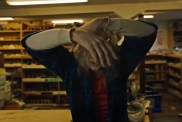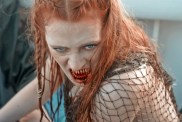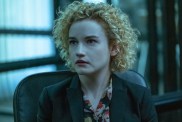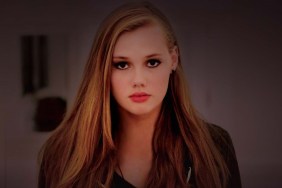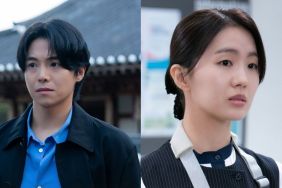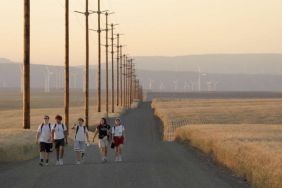Neil Gaiman & Henry Selick’s dark fantasy

The outside of LAIKA Studios seems so unassuming against the grey Portland sky. Stepping just inside the front door, I catch a glimpse of the Coraline movie logo, proudly displayed in enormous letters just behind the receptionist. That aside, though, I could be standing anywhere. A doctor’s office or a law firm. There’s nothing here to betray LAIKA’s lobby as anything other than a straightforward business except for a rising excitement I get as I look eagerly to the next door and know that I’ve arrived somewhere far from ordinary.
They’re about to show us something magical.
On the flight to Oregon, I reread Neil Gaiman’s original short novel. It’s a quick book and one that I’ve come back to time and again since it first came out in 2002. I’ve passed it along and recommended it to family and friends. To people much younger and much older than me. I find myself doing that with most of the things Neil writes.
This time, as I’m reading it, the film version is very much on my mind. Every sentence, I pause and wonder if that bit will make it into the film or if it might get changed or taken out altogether. I worry that it’s not even possible to capture Neil’s style properly on film. Despite some valiant efforts, no one has ever really pulled it off.
The next door opens and I’m taken into a meeting room to wait for Henry Selick to arrive. On the table in front of me are all the characters in model form, ranging from six inches tall to nearly two feet. I try to ignore the labels by their feet and guess who they are just from the look. Except for one character created especially for the film – a young boy Coraline’s age – they’re all there in both their regular and “Other” forms.
In the book, Coraline is a young girl who comes across a doorway into another world that – though in many ways it looks just like her regular life – is inhabited by “Other” versions of people she knows. She has an Other Mother and an Other Father and – in this new world – they all have buttons for eyes. It’s really awfully creepy and I’m delighted that the models on the table don’t back down on that front.
Henry enters the room with a somewhat awkward but incredibly friendly smile. His voice and manner are soft and kind and he reminds me of a shop teacher; someone who doesn’t find it enough just to have great hands-on skill but who can’t be happy unless he’s sharing it with the world. In the case of Coraline, he’s serving double duty as both director and screenwriter.
“The movie’s different,” he says, right off the bat. “But it’s very important to have it appeal to the book fans. Because I was the very first.”
He moves through the models, one by one, talking about his inspirations and what he’s done to move them into the three-dimensional world. One of the biggest changes is one of scenery. Where the book is set in England, the movie Coraline takes place in Oregon. Henry notes how impressed he is with Dakota Fanning (who provides Coraline’s voice) and her subtle Midwest accent that she’s brought to the film.
He smiles at the mention of Oregon, adding, “When I wrote that, I had no idea I would end up moving out here.”
John Hodgman provides the voice of both Father and Other Father while Teri Hatcher does the same for Mother and Other Mother, the latter of which is represented in the models with three increasingly monstrous forms. “She’s a pretty hardcore bitch,” Henry says with a kind of shy smile. “And you know what? I kind of like her for that.”
Acclaimed voice actor Keith David plays the Cat, who serves as Coraline’s guide through the other world.
“The cat’s a very important character,” Henry posits. “He’s sort of Coraline’s guardian angel. He’s in both worlds. There isn’t another cat.”
The new character, Henry says, is named Whybe (short for Whybourne) and was created to give Coraline someone to play off of. In the book, we’re privy to her inner thoughts so he allows her someone on-screen to talk with. He also exists in the Other world, appearing as a mute with button eyes.
Reaching the end of the characters on the table, Henry leads the way down the hall and into the heart of LAIKA itself. The deeper we get, the more I’m surprised by the sheer size of it all. The first stop is the costume shop where, at several desks, women sit working on tiny costumes. Each character model is built so that that the model can be reused with different clothes. Because of wear and tear, some outfits are duplicated 30 times with the same exact detailing.

Some of the costumes are constructed from scratch. There’s one woman who was brought onboard who specializes in miniature knitting, making sweaters as small as an inch big. Equally impressive, though, are the costumes made from everyday objects. One of the models – a background townsperson – sits on the desk with an outfit made from an ordinary tube sock, recognizable only when it’s pointed out as anything other than a sweater.
Moving down the line, I’m taken to the model shop where the characters themselves are made. It’s an enormous room, filled with people working at desks littered with tiny nuts, bolts and joints. Every character is built to be posed endlessly, capable of assuming any pose a live actor can.
Scott Tom, the Puppet Fabrication Supervisor, explains the process of translating preliminary sketches into three dimensional models. After a look is decided on, a non-poseable 3-D model is constructed called a maquette. That enables the model builders to see what the character should look like in three dimensions before constructing the poseable versions.
The poseable characters are built around a metal armature that works like a metal skeleton, riddled with tiny joints that are then covered with a form of silicon skin. The skin allows for soft movement, covering the metal joints while retaining poseability. Other parts are designed to be interchangeable like the characters’ hands – over 1,000 different pairs of hands have produced for this film alone.
The tour of the model department ends with hair, one of the hardest elements to animate. Susan Multon is in charge of the department and points out that there are 38 hair sets for just the Coraline character and the character that she’s working on right now – the Other version of Ms. Forcible, one of Coraline’s neighbors, has five miles of metallic thread worked onto her head.
Henry leads on to the art department where we run into Lee “Bo” Henry. He’s a fantastic looking character in his own right with a great white mustache and an excited grin to show off some of the small-scale props – everything from tiny hand-painted leaves to a not-so-small moving van that comes up to my knees.
We move right from there to the first of several sets. Because the actual shooting moves at such a glacial pace (Henry says each camera is lucky to get about a second or two a day), many different scenes shoot simultaneously.
In the first curtained area, a set is still being constructed for the garden outside Coraline’s house. The set is immense; about 25 square feet and built so that smaller sections can be removed and replaced by the camera and lights, depending on the shot. It’s almost eerie to look at. It’s so detailed and it feels like an optical illusion spreading out across the room.
In another section is the outside of Coraline’s house, lit by a majestic artificial night sky. Stars actually twinkle on a dark blue backdrop behind the set where, in a small corner at the front of the house, an animator works on a dialogue scene between Coraline and the cat.
Another set is entirely white with little floating boxes of color that hang down on invisible strings. In the scene, Coraline has walked beyond the limits of the Other world and matter no longer exists. The camera tracks her movements with the cat as the boxes diminish and she moves from a dirt road into absolute emptiness.
There are two sets of the Other Mother’s living room – a location that seems to intensify through the course of the film. There’s an insect theme to the decor with a large bug table, wardrobe and lights and even they have buttons for eyes.
The two most impressive sets, though, are saved for last. The first is far and away the biggest; a scene in dark forest where animation supervisor Anthony Scott has to work with thousands of tiny leaves. For a shot where the wind blows through the scene, he has to climb atop the set and move each branch by hand for every single frame he shoots.
The last set features a playhouse where the Other versions of Coraline’s neighbors perform an elaborate song and dance routine. There are audience members in the foreground, people giving performances on-stage and a moving background of curtains and backdrops that all have to be considered when working towards the final product.
With the tour coming to close, I’m taken to LAIKA’s private screening room and given a pair of 3-D glasses. I get to see about 20 minutes of finished film (much of which is shot on the same sets I’ve just seen) and I’m happy to report that it holds very true to Neil Gaiman’s book, albeit in a somewhat indirect manner. The spirit is there, even if a few of the specifics are not. In fact, it really is the perfect balance; as much Gaiman as it is Selick. The 3-D, too, is gorgeous and somehow comes to life much more so with the stop-motion than I’ve ever seen it do with live-action.
Henry leads the way back to the waiting room and I catch him smiling. He’s well and truly happy that the footage has gotten such a positive reaction. I walk back through the curtains leading to the plain, ordinary lobby, once again smiling to consider how deceptive it is compared against the magic inside.
“We keep trying for perfection,” Henry says, perfectly summing up his craft. “But we’ll never get it. And it would be a mistake if we did.”

Following the tour of LAIKA studios, Henry Selick sat down to answer questions about his work and the collaborative effort behind Coraline. Describing himself as the book’s “first fan”, Selick went after the rights before the book was even published. The road to making it into a feature film has been a long one and incredibly near and dear to his heart.
ShockTillYouDrop.com: What was your favorite thing to bring to life on-screen?
Henry Selick: The characters. That’s what I always saw as the challenge in bringing to the screen in animation. As far as individual scenes and moments? The mouse circus. Some of the things I showed you today. Spink and Forcible. Things that I didn’t show you. When she goes down and has her tea leaves read and you get first introduced to them and see what their world is like. There was this incredibly critical scene when Coraline has come to this other world. In the book, it’s really one main visit and all these things happen and she escapes only to discover that her parents are missing. They were lured over there. To the other world. We do [it so] she travels back and forth a few times. First in dreams and then, after a particularly bad time with her mother, her mother goes out food shopping and Coraline gets the key to that door and opens it knowing that it’s not a dream, it’s real. And it is and she goes back for the greatest show yet. The capper is that her other mother tells her, “Well, you could stay here forever. There’s just a little thing you have to do,” and this right from the book, “Oh, it’s just a little thing.” And it’s sitting her down and, “We have a surprise,” and it’s a box of buttons and a needle and thread. It takes her a moment to understand. “What’s this?” “Well, if you want to stay here, we just have to sew these buttons into your eyes.” So it’s sort of the price to pay if you want to be here. And what rational person would ever agree to that? But she finds out that the ghosts of the children before her wanted it. They wanted what the other mother had to offer and they agreed. That was a scene that I always knew was going to be tough to pull off. To get the right balance and not make over-the-top and like her parents are monsters. They’re very reasonable in the way we’ve done it and it takes Coraline a while with a lot of shots back and forth. That was one of the key scenes from the book that I was wanting to bring to the screen. Can we do it? You saw, these are puppets. They’re made of metal and silicone and plastic. Can we get the audience to believe in them enough so that a moment like that – a horrific moment – has impact. It’s unexpected. It’s unsettling. I think it’s working. So that was maybe one of the most critical ones.
Shock: In regards to the 3-D; Are you shooting this in a way so that it will still be visually engaging to the audience after it makes the transition over to DVD and you don’t have that 3-D effect?
Selick: Mainly. Most of the time, I’m watching it in 2-D when I’m working on it. I don’t go out to every set every day but all the animators come to see me in editorial at the start and end and all the rehearsals. We have two edit rooms that we’re jumping back and forth that we’re only looking at in 2-D. We check shots in 3-D. So, I think it’s going to work great.
Shock: So you’re not using 3-D as a main selling point? It’s just a compliment?
Selick: I would prefer if the number of theaters existed – I mean, certainly in the States the number is going up. It’s not my call but I think it’s a better experience when it’s 3-D because we’re using it as part of the story. The other world has this richer feel to it. We’re not like cranking it up over the top with stuff shooting up at the screen all the time. In the end, the story and the characters are the thing. I believe – I hope – that they work well enough for 2-D. Now there’s high-def DVDs, Blu-Ray. There is actually real good 3-D capability down the road for home screens including no-glasses 3-D. Phillips Electronics and Lenny Lipton, who’s part of the company RealD which is kind of the premiere 3-D company. They work with exhibitors. It’s their system software/hardware that is going into the majority of theaters. So anyway, it will work in 2-D and work quite well. That’s how I actually deal with a film most of the time. But I think that 3-D is just a more memorable experience. It’ll be coming online for home screens, too, but for now, theaters will be the best place for a number of years.
Shock: When did you first discover Neil’s work and can you talk about how this project first began for you?
Selick: I wasn’t really aware of Neil from the start of Sandman and some of the other kinds of different things. Graphic novels, when that first happened. The Dark Knight and Watchmen – I was right there in the early years of that and then I was kind of in and out of it. But I first met Neil in 2000 and it was just, “Here’s Neil Gaiman and he has this book.” It wasn’t published. It wasn’t even finished. I think he called Tim Burton and he called me and I’m the one who called back. I worked with Tim on a number of films. I got to read it and I took it to Bill Mechanic who had been the head of Fox and had an independent company, Pandemonium. I could just see it right away as it movie. I saw it as edgy. But Neil said from the start – and he’s always been right about everything – but kids saw it as an adventure and adults saw it as something really frightening. He’s got three kids and as they were growing up, he worked on Coraline for a very long time. He started it for his older daughter, she grew up and then he used his younger daughter for the inspiration. In the book, you’ll actually see that Coraline seems to act different ages at different points. It was just one of those things. I thought it was ready to be made into a movie just like that. I saw Neil do a reading of short stories and he was like a rock star. He was great. I mean very charismatic. Him reading his stories, you’ve got every nuance. There’s a lot of humor in Neil’s work. Even in his darkest work. In Coraline, the book, there’s a lot of very dry but exquisite humor and we try to hold onto that as well. We connected. We went to Bill Mechanic and I convinced them to let me write it. It’s practically written but it was actually a lot of work to turn into a screenplay. Bill wanted it to be live action. He was adamant that it go that way and it took a long time. You know, going away and doing other things and coming back to it to get the screenplay to work and sort of pull it back to where I first saw it. I felt this is a scary book for kids. If it’s animation, it takes a little of the edge off the worst moments but it keeps the Grimm’s fairy tale quality. But it was a pretty long journey from 2000 to now where we’re almost finished. I feel very grateful in getting to make the movie that I wanted to. Neil’s very happy with it as well. I’ve shown him reels of the entire film and he’s great at input. He focuses on one little thing and he’s almost always right. He never goes, “Well, this isn’t the book anymore!” or “This didn’t happen!” He totally understands that movies have to be their own thing and it’s been a really good relationship.

Privately, I’m not sure. But he never got angry. Here’s really what happened. The first screenplay I wrote, I was thinking, “Neil’s a hell of a good writer.” I’ve always written as a director because you have to do rewrites and you can’t get the writer so you do your own dialogue. I’ve written things on my own but this is the first official screenplay I was being paid to write. You know, Bill Mechanic is pushing for certain things. The first screenplay I wrote was too faithful to the book. It was exactly the book. It was one of those things where, on the one hand, I was interacting with Neil a lot and I think he was flattered but it didn’t work. It wasn’t a movie. And I had to not interact. I had to not talk to him for a year. I had to go off and tear everything apart and then try to put it back together in a way that feels like the book, that has all the elements from the book, that’s very true to the nature of the book but it’s been turned into the form it is. Whybe became one of those things. Coraline, we can read her thoughts and what’s she’s thinking but I don’t want to have voiceover. What can I do? There was definitely a push from Bill Mechanic. “We need a lot of kids! Where are the kids?” I focused on one that I thought worked. You’ll need to see the movie to see how he plays. Neil never…he seems fine with it. He seemed fine from the start. He would question a few things but it was this odd thing where I stopped talking to him for a year. Then I wrote the real screenplay and – I’ll be honest – I was terrified for him to read it. I had everybody but Neil read it. But I finally said, “Well, I have to have Neil,” and he said, “You know? This is much better than the first one.” He was great.
Shock: What can you tell us about the musical aspects of the movie?
Selick: Early on, there were going to be more songs. I thought there was a way to do that. We worked with They Might Be Giants on several songs. In the end, there are only a few moments of music that are part of the story. They Might Be Giants are incredible. They do a song and John Linnell sings the other father’s song that he’s written for Coraline. Coraline’s father is busy writing. Him and mom are like behind schedule on this really important gardening catalogue they’re writing. He has no time. He’s at his computer in the room, just like the book. In the other world when the other mother tells her, “Go get your father. Tell him supper’s ready,” she goes to what appears to be the same study door. She opens it and there’s the father in what appears to be the same position but instead of a computer, he’s sitting at a piano, tapping notes. Coraline’s surprised. “My father can’t play piano!” He says, “No need to! This piano plays me!” Sort of mechanical hands come out with gloves that slip over his. John Linnell wrote this great song just about Coraline. It’s sort of out of control and perfect. So we have that. As far as the ladies in the downstairs theater, they sing this salty song. I wrote that. I tried to get They Might Be Giants to rewrite it and they said, “No, it’s fine. It’s perfectly fine.” I still think they would have done a better job but it’s my song. The score is by Bruno Coulet. He’s a French composer. He did Winged Migration, Microcosmos and several European films. I think one Danish animated film. When you’re making a movie, you always put up temp music, especially when it’s a bunch of storyboards or a rough cut. You want the movie to sound big. It really helps. It helps you tell what’s working and helps an audience if you’re showing it to execs or anyone. Everything we tried was either too scary and dark for a straight horror film and if it was a kids film it was too light and fluffy. Bruno Coulet just happened to be one of the billions of CDs we popped in to see if something was a more honest portrayal of the magic of childhood and the terror of childhood. It was just this fit. We contacted him and he was available. He’s written about half of the music so far for the movie. He’s written it on synthesizer and things and 90 percent of what he’s written is perfect from day one. But it’s a very, very fine line. The tone of this movie is the razor’s edge. We want it to be fun at one moment but also to have life or death consequences at others.
Shock: Was the footage we saw the temp score?
Selick: The music with Bobinksi at the top of the stairs was his music. The circus mice was not. A friend of mine wrote something that we could just animate to. The other was not. Just the first piece.
Shock: Aside from the removals you mentioned, will there be any visual effects shots?
Selick: From repair work there’s removals and that seam in the face where you’re changing eyebrows and mouths. There’s a fair amount of visual effects. Like when all the flowers blossom in the fantastic garden, some will be manipulated by the animator and others are being shot off-screen and manipulated by an animator. But then visual effects will populate a whole hillside with them just because that’s the better way to go. We have someone named Brian Vant Hall who’s an Academy Award winner and someone I worked with back on Nightmare Before Christmas. He’s at WETA and has been working for years there with Peter Jackson. He wanted to work on something that he thought would be simpler. More handmade. A mix of practical effects and CG and digital. I wanted to do it in-house. I wanted to shoot a lot of good stuff. There’s a lot of visual effects but we’re trying not to make it CG generated. But CG is the way it gets put together. There’s a few really good tricks. We have cotton fog and his guys touch it and it moves and makes a huge difference.
Shock: Has there been any discussion of a toy line?
Selick: We’ve been in talks. Can I talk about this? About the people who’ve been here? Hot Topic. There’s that chain store for goth kids, outsider kids. Hot Topic.
Publicist: And NECA has been here and is very interested in doing a lot of product around Coraline.

Selick: There’s interest. I know because every single thing you see on-screen, every single character design, I’ve got kids now who are growing up. They’re nine and sixteen but in the years I’ve worked on this they’ve grown. I run things by them and their friends. My niece. I just like to see what kids think of this and yeah, they would want to get their hands on some of this stuff. I’m actually more than half serious when someone asked in puppet-fab, “Are you going to go right on to another film? Or, what are you going onto next?” Well, cranking out puppets and selling them. We’ve got the world’s experts right here.
Shock: How has the experience of this compared to that of your other full-length feature films?
Selick: In many ways, it’s most like “Nightmare”. “Nightmare” was a situation where Tim had dreamed up a brilliant story, a concept and the main characters and then they wouldn’t let him make it at Disney. I was friends with him then at Disney and worked with him and saw the first presentations. It was years until he had the power to come back. It was still owned by Disney but there was really zero studio interference. It was a low-budget film. We would get notes. Jeffrey Katzenberg was still at Disney then. I would go to Tim and say, “What should we do?” He’d say, “If something works, do it”. Otherwise, it didn’t matter. He was the godfather of the project and he oversaw everything. He was making two other films so he wasn’t questioning anything. He just loved it. It was like getting a gift from us every week. There’s one shot we had to re-shoot for him. It wasn’t dark enough. It was about 99% of all the artists’ energy that went into the movie. This film was harder to get going but once we got going, we had the same kind of artistic support. We have great distributors who have been very supportive. They recognize it as an edgy family film. Not just like anything else. It’s most like “Nightmare” for artistic support and I think for the crew’s investment. I know a lot of people are pretty tired at this point but the fact is every day you get to see a small miracle or ten and every week you see a larger miracle. I think we’re all pretty impressed by each other and inspired by each other. It’s like an artistic community you don’t often find after you’ve gotten out of Cal Arts or some other art school. It’s been an amazing, positive experience.
Coraline opens in February of 2009.






Source: Silas Lesnick

